
Posted by
Mordy Oberstein
Google revenue can mean only one thing, ads. While proportionally speaking that’s true, Google does dabble in other avenues of revenue, and sometimes right under your nose. Google’s very own SERP features provide it with a subtly powerful way to supplement its traditional form of income, i.e. ads. In fact, there are some unique advantages to garnering income via SERP features that ads can’t provide Google with.

Such advantages could be why Google has bolstered those features that do currently, and may in the future, provide it with additional sources of revenue. In fact, I would be so bold as to say that in-feature revenue is the future of Google’s monetization strategy. Here’s why:
Google SERP Features as a Source of Revenue
When it comes to bringing in the Benjamins (or any other form of currency) the recent past has indicated that Google is taking in-feature revenue quite seriously. A series of upgrades to some of Google’s traditional SERP features points to a renewed focus that could bring this form of revenue generation into the limelight. That is, Google has long been in the habit of earning income via its SERP features.
Google’s Flight Box is the the perfect example. Searches related to flights often bring up Google’s listing of flight availability. Google refers users interested in booking a flight to the airline’s website and in the process quite often collects some sort of referral fee. However, the recent upgrades to both the Flight Box and hotel Local Panels bespeaks the possibility that Google’s in-feature referral income might soon be taking a more prominent seat at the revenue table. With that, let’s take a look at these upgrades.
Flight Box Gets Bumped to First Class
Just so we’re all on the same page, Google’s Flight Box was already a powerful tool with which to find a darn decent airfare. Search for a flight between two destinations and Google made it pretty easy (though some would argue a bit confusing) to book a seat on your favorite (or not-so-favorite) airline. During this process Google would/does prod you to purchase your 18.5 inches of sitting space (the average width of a seat on a plane) via the airline directly. In doing so, Google receives some sort of compensation in some sort of way, as its exact agreement with the airlines is a bit ambiguous. But worry not, Google gets paid for sending you, the user, to an airline’s site for direct booking.
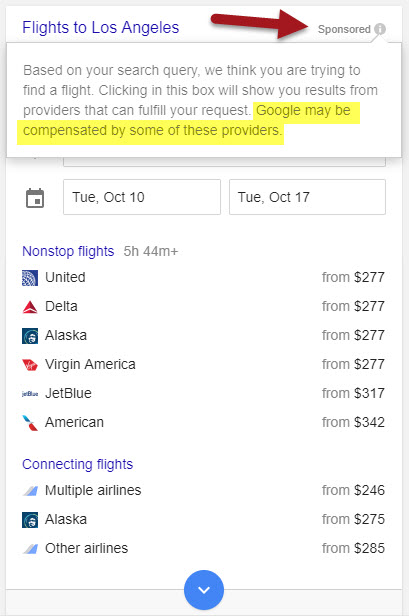
Google fully discloses that it may be compensated for its flight referrals…. in some way and at some point
Then, without warning, Google went ahead and turned a pretty good SERP feature into a monstrous airfare booking behemoth, or in plain language the Flight Box was the recipient of a serious upgrade. Now if you search for a flight on mobile you’ll most likely notice a carousel that reads “Flight insights.” And just what are these flight insights? Well, they’re Google’s way of taking the Flight Box to the next level. How so?
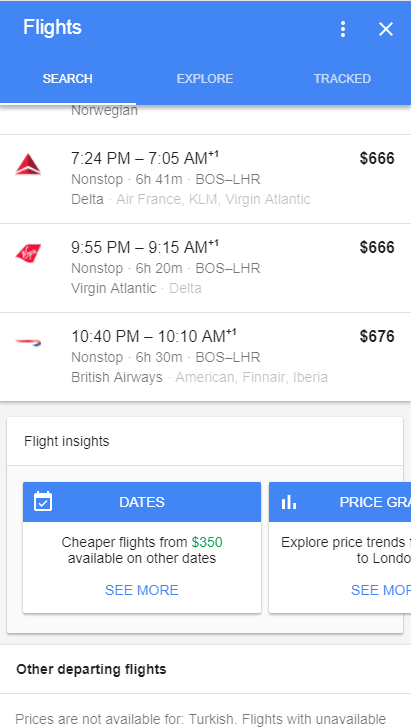
The new Flight insights carousel that appears upon expanding a mobile Flights Box
1) Calendar Pricing:
The most prominent addition to the Flight Box is a calendar that lists flight prices on a per day basis. The calendar has a sliding x and y axis that allows you to see a combination of fares for both your initial departure and return trip. Google even has a color coordinated system that tells you which price is the cheapest and which is the most expensive.
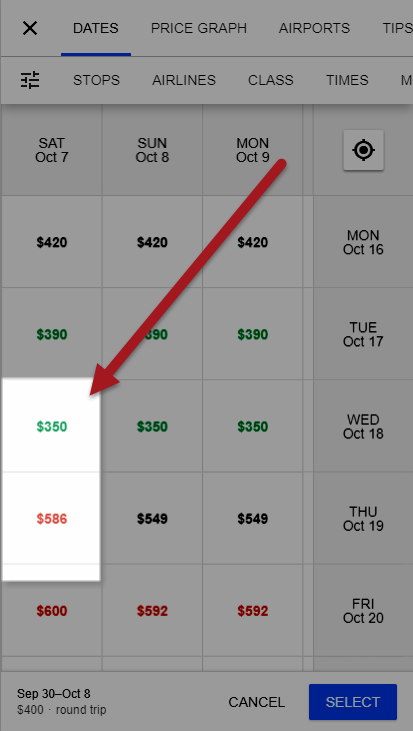
The new flights price calendar is color-coded to show both the lowest and highest rates
2) Flight Specifications: The new flight pricing calendar is by no means linear. Google offers you the ability to filter the prices shown by airline and class. Meaning, if you only want to fly first class on a select few airlines, the choice is available to you.
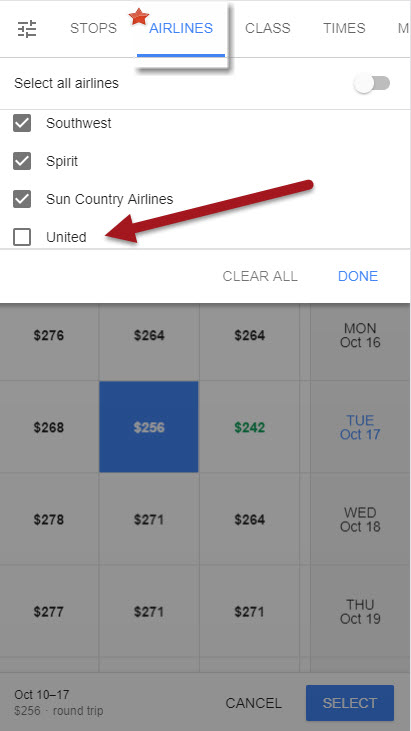
Filter which airlines you do and do not want Google to display pricing for
Of course you can choose to show only direct flights as well (which if you’re paying for first class, you might as well do anyway).
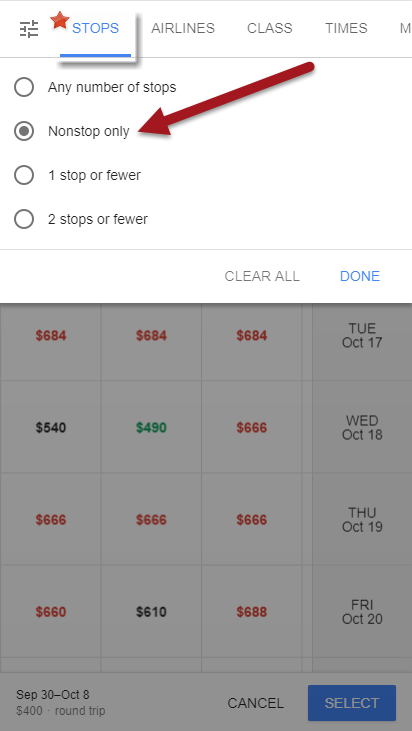
Select flight stop preferences within Google’s upgraded Flights Box
In fact, and I just **** this one, Google enables you to only show prices for flights that fit the time of day you prefer to fly. So for all of you red-eye fanatics, you could certainly choose to set your flight options up accordingly.
3) The Price Graph: I will personally tell you that the most frustrating part of booking a ticket, at least for me, is figuring out the optimal length of the trip. How many times have you played a game of trial and error entering **** after **** into a booking site to see how the flight prices change? Is a 10 day stay significantly cheaper than 14 days? The price graph solves this. Enter the length of trip into the tool and simply scroll to the right in order to see how the prices fluctuate.
Now you could do the same on the calendar pricing itself, but the visual aspect that Google provides makes the process much more accessible. It’s a great tool if you have some flexibility in your travel dates. (Note: All of the filters available within the price calendar are presented here as well).
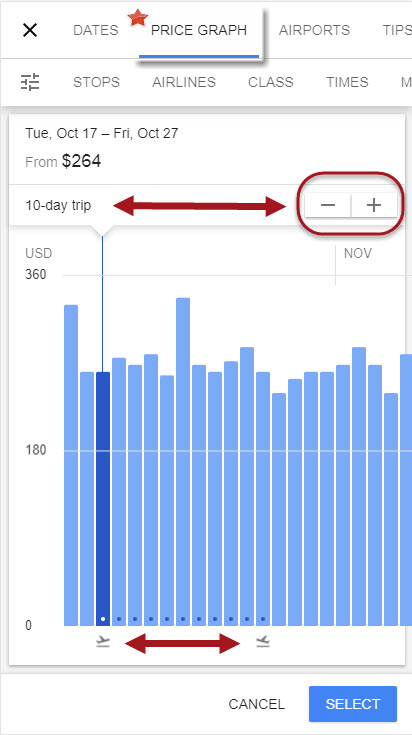
The Price Graph presents the price trends while indicating the period of your selected trip
4) Multiple Airport Selection: One of the biggest upgrades Google gave its Flight Box is the ability to select which airports you want shown within price results. The upshot is, while a specific airport may be three hours away, the flight you want may be substantially cheaper. Now traditionally, only those airports within the immediate vicinity of the search would be taken into consideration. Google’s new feature lets you see the best rate at a series of airports, even those outside of the “city limits” so to speak.
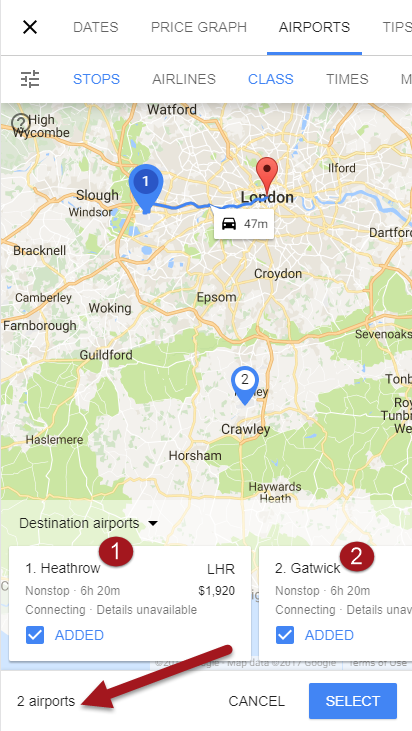
Choose which airport(s) you wish Google to display flight prices for
Now, on top of all this, Google also offers what it calls “flight tips.” Currently, the feature mainly presents a link to a travel guide related to the destination city. I can only imagine Google is considering offering promotions and whatnot within the section. Whatever Google has planned, it’s not just a link to its travel guide or a price tip here and there. Expect to see more here going forward.
It’s High Living in Google’s Updated Hotel Local Panels
Concurrent to Google’s Flight Box upgrade, Google overhauled the hotel booking features found within its mobile Local Panels. The enhancements here are a bit similar to those within the Flight Box, just not as extensive. To that extent, the **** selector within the mobile Knowledge Panel includes daily rates and allows you to select both start and end dates that results in an overall price.
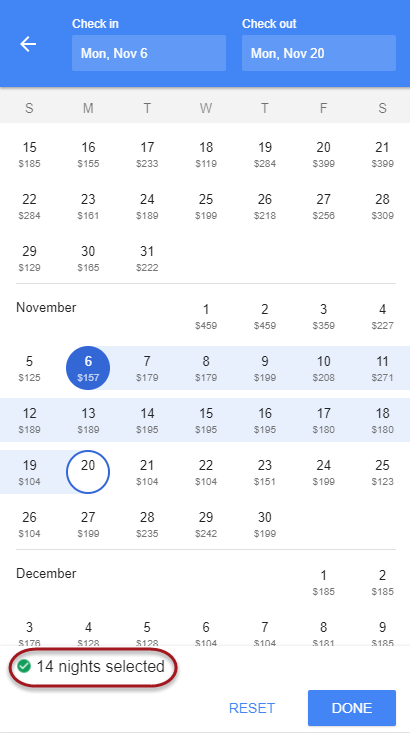
Daily hotel rates as shown on the upgraded calendar within hotel Local Panels on mobile
Again, similar to Google’s revamping of its Flight Box, you can access a price trends graph that visually illustrates the hotel’s prices going forward. The graph is an easy way to gauge the difference in price between two time periods. It’s a great way to track when a hotel’s pricing may begin to fluctuate (think holiday season).
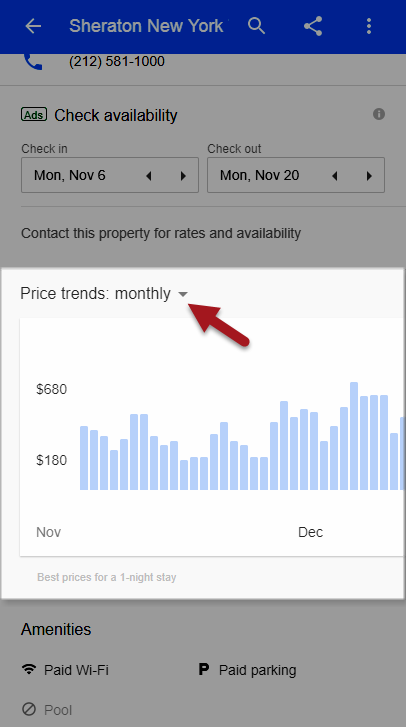
The upgraded Price Trends Graph set to show monthly trends
While hotel pricing features within the Local Panel did not get an as prolific overhaul as Flight Box, that’s not to say that Google is not as interested in hotel bookings. In this instance it’s important to consider that unlike the Flight Box, Google is constantly tweaking how it goes about hotel pricing within the Local Panel, adding new and significant features on a regular basis.
Making Sense of Google’s Travel Feature Upgrades

Let’s leave aside “why” for a second. Why Google undertook these upgrades is a great question. However, and not get too Aristotelian here, but let’s deal with what first. What does it say that Google has made these deep flight and hotel upgrades? What’s the underlying message here? What’s the takeaway?
First things first, the Flight Box and the hotel Local Panel updates are all part of the same package. They are intrinsically tied and part of the same “direction forward.” How do I know? Simple, they were both announced by Google at the same time, together in the same release. That’s an important point to consider. See, at times Google may decide to update a certain SERP feature in order to increase the feature’s scope, functionality, or even efficiency. In other words, a change to a SERP feature is often feature-oriented. Google often wants to increase the scope of the feature so that users will be “happier” with the feature per se. In such cases it’s about improving the feature itself.
Not so here. Here, we’re dealing with similar functionality across two totally different SERP features. Meaning to say, the functionality and the effects that such functionality produces is of interest to Google. These upgrades are less about the the feature(s) per se than it is about what the feature(s) are able to produce. If Google were say interested in satisfying the users with an upgraded Flight Box, why would it lump it together with an upgrade to hotel Local Panels?
Methodically speaking, what is the common element between the two upgrades? Is it simply the functionality? Is the connection merely that both upgrades exist within the travel industry? Saying so seems oversimplified, especially for Google. For Google to release both upgrades together, in the same announcement, it means that they share an intrinsic sort of commonality.
Increased Travel Referrals
What is it then that both upgrades achieve? Referral expansion. Again, it’s no secret that Google earns revenue by referring its users to airline websites. The new and improved Flight Box greatly increases the likelihood that a user will use Google to search for and ultimately book a flight. This means that the chances of Google garnering its flight finder’s fee also greatly increase.
The same holds true in regards to hotels. Though more conspicuous than flight referrals, Google does refer a user to a hotel’s site or third party sites for bookings. Within the list of booking sites and their prices, Google often refers a user to book directly with a hotel by showing the hotel’s site within that list. Unlike the the Flight Box, Google does not offer a disclosure regarding its referral revenue. However, note carefully where the hotel’s listing appears:
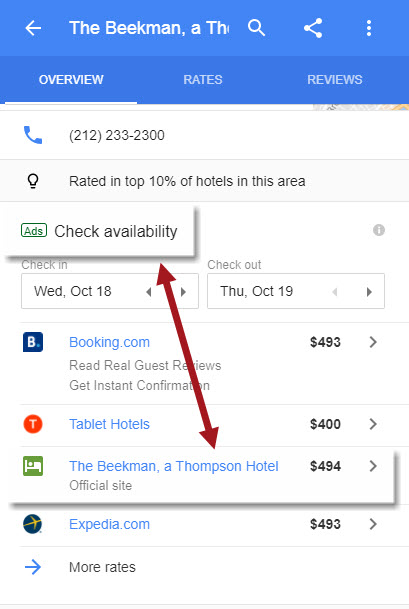
Notice, the hotel, like the third party travel sites, is presented within the section of the Local Panel that reads “Ads.” It’s quite common to see the hotel itself listed with the third party sites. This is because in 2015 Google made it easier for hotels per se to compete with the big booking sites. The ads you see in the Local Panel are not CPC. Rather the ads are commissioned based. Should a user book with either the hotel itself or a third party site, that site is now obligated to pay a commission fee.
In fact, a user can at times book a hotel room directly with Google. In such cases Google’s booking is either via the hotel per se or a select group of partners, with a commission forthcoming in either case. Meaning, the way Google earns money from hotel bookings, is not that different from how it makes money off of flights, no matter how different the revenue disclosure process may be.
So what’s the essential bond between the Flight Box and hotel Local Panels… well it’s the method of revenue. Google’s recent upgrades are geared towards garnering more commissioned based revenue via its SERP features. Why were both of these features upgraded at the same time and in the same sort of way… because vis a vis revenues, they are the same SERP feature.
Back to our what question…. What was Google doing with its recent travel feature upgrades? Why it was bolstering and shoring up its commissioned/referral based revenue by making prolific its flight and hotel bookings.
Why Did Google Upgrade Its Travel Booking SERP Features?
Now we’re ready to ask why. Knowing what Google fundamentally did we can now ask why they did it. Not only that, but why now? What’s going in the greater Google universe that would precipitate a renewed focus on commissioned based/referral revenue? For this I have three theories. Why three theories? Because it’s better than just two theories (and four would be overkill).
Theory # 1 – Why Now…. Why Not?
As my uncle is fond of saying, “Why ask why?”. As a ten year old I found this question quite confusing and as I got older it became clear that my darling uncle was intent on such an effect. The trauma of my childhood aside, the answer to why Google decided to suddenly renew its referral revenue tactics is possibly as simple as asking, why not go for it? That is to say, there’s no specific reason why Google has swiftly upgraded its commissioned based revenue features. The timing could be boiled down to the upgrade being next on Google’s list.
While I can’t deny the possibility, we all know Google a bit better than that right? Which leads me to theory #2.
Theory #2 – Too Many Ads

There is such a thing as ad saturation. Facebook has fretted over ad saturation in the past, worried that too many ads in the News Feed would deter use. In fact, Facebook began to monetize Messenger as a means of dealing with this ad overflow. Google, giant as it is, broad as it is, faces the same concern. Google ad saturation is a possibility according to some experts. In the face of reaching its ad limits, in-feature revenues are a viable option for continued income growth.
Theory # 3 – Too Few Ads
No one knows what the future will hold, but the possibility of Google having too few ads is a possibility (just as having too many ads is). As part of what is a high stakes tightrope act, Google needs to balance revenue generating ads with a satisfactory user experience. Meaning, Google needs to, and in fact has, dealt with limiting low-quality and intrusive ads. However, it still has a ways to go, and in the age of the ad blocker Google was painted into a bit of a corner.
That is, Google was forced to deal with the ever-growing popularity of ad blocking technology and the implications of its reliance on ad revenue. To deal with this, Google decided to take charge and place the rules of the game under its thumb. How? By announcing it is releasing its own ad blocker in the next update to Chrome, a Chrome blocker. In this way, Google decides which ads fall under the blockers scope and which do not (as opposed to some third party software).

It’s a brilliant, yet simple, piece of maneuvering. However, at the end of the day, there will be less ads out there for Google to collect money from. In light of this, a renewed focus on in-feature referral/commission revenue makes a lot of good sense. With in-feature revenue, Google not only makes all of the rules, but has a slew of revenue possibilities at its fingertips. Meaning, the limits are only set by Google’s imagination and I’m sure Google can imagine a lot of ways to monetize elements of its SERP features in all new ways.
Why In-feature Revenue Is the Future of Google Monetization
There are a lot of good reasons for Google to bolster its in-feature monetization efforts, but what about it makes it the future of Google’s monetization strategy? Good question and I have two reasons for you.
1) In-feature revenue is untapped and endless: As I alluded to earlier, Google’s in-feature referral/commission revenue streams are only as limited as Google’s creativity. There are simply a ton of ways to monetize SERP features. How so? Simple, many SERP features deal directly with businesses and are primed for monetization possibilities. Think of a Local Knowledge Panel. Here Google deals directly with thousands upon thousands of businesses all hungry for their own revenue. All Google has to do is engineer the panel in such a way that it can offer these businesses and subsequently itself revenue possibilities.

Google recently did so by partnering with a software firm in order to allow users to book an appointment at a yoga studio. Think of the possibilities within this one very limited SERP feature element. How much could Google earn referring patients to doctors, hungry patrons to restaurants, or eager buyers to a real estate agent? Now consider that this is one tiny element of a Local Knowledge Panel. What if Google developed a new way to use the Knowledge Panel to earn revenue? What if Google decided to create a whole new SERP feature in order to do so? Some speculate the new Google for Jobs feature is just this. To drive the point home, in-feature monetization is simply an untapped and underdeveloped source of Google revenue.
2) Overt monetization leaves a bad taste: It’s an interesting psychological reality to point out, but whenever someone pursues profit, there is a large degree of skepticism as to the morality of the pursuit. In Google’s case, the search engine meets tremendous scrutiny when it goes about propagating its advertising business. Sometimes there is justification, take the relatively recent YouTube ad snafu. On the other hand, Google is a for-profit company, it’s supposed to pursue profit possibilities! Yet, whether wrong or right, Google’s advertising pursuits are often hyper-scrutinized and taken to be conniving and dubious. True or not true, it’s bad press. Google going for in-feature revenue bypasses public relations complications, for the most part.
I’m not saying that Google is overly concerned that it will develop a bad reputation due to its advertising practices, though again the YouTube ad placement scandal didn’t help things. In fact, Google going in-feature could be seen a response to the YouTube ad situation. In any case, Google’s in-feature referral/commission based revenues generally fly under the radar. It’s only industry mavens like ourselves who are aware of Google’s more subtle income generating practices.
Let’s give this some more teeth. Imagine you’re Google. You get flack for every attempt to garner more profits. Every change you make to your ads and ad policy is taken as a hostile act. You’ve recently been subject to a bit of an ad scandal. Wouldn’t you want to take a break from the front line fight and covertly pursue other revenue options? It’s not that you’re afraid of a good fight, or can’t win it. It’s about not fighting a fight you don’t have to. It’s about garnering income without all of the hoopla. With battles like the YouTube ad placement blunder behind it, and with an appeal underway in an effort to avoid paying an EU penalty related to shopping PLAs, if I was Google, I’d like to avoid the revenue limelight for a while.
The Smart Money – Why Google’s New Strategy Matters
My money’s on Google only increasing its focus on monetizing its SERP features. If I had to double down on a specific feature that will see increased monetization, I would bet on the Local Panel, especially on mobile. It’s the natural choice for Google. With the Local Panel there is an intrinsic connection between a business and Google that predisposes monetization in a way that could truly benefit both parties.

If it were me, if I was doing SEO for a small business, I would keep my ear to the ground and on the lookout for ways to capitalize on Google’s business referral focus. Forgetting any other issues, Google referring business your way could be a big boost, and that’s most likely a big understatement. If what I’m saying pans out, an entire new scheme of how to garner revenue from the SERP, in fact how to approach the SERP altogether emerges. Just consider the revenue possibilities and then consider what you want to show up on the SERP. Are you still hoping for an organic link on top of all other organic links or for a Local Panel with your name on it? If you answered the latter, now that’s a whole new SERP strategy that in my honest opinion would have to go beyond keywords and ranking and into the fray of brand recognition and authority.
In short, Google going all-in on local business referrals could change the way the local SEO game looks…. Happy future hunting.
Discover how Rank Ranger can enhance your business
All the data in insights you need to dominate the SERPs




